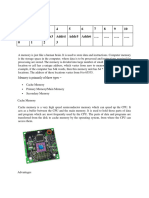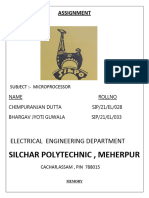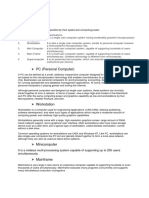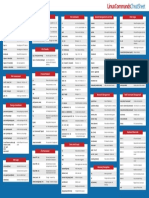Computer Memory
Uploaded by
shyinaComputer Memory
Uploaded by
shyinaCOMPUTER - MEMORY
http://www.tutorialspoint.com/computer_fundamentals/computer_memory.htm
Copyright tutorialspoint.com
A memory is just like a human brain. It is used to store data and instructions. Computer memory is
the storage space in computer where data is to be processed and instructions required for
processing are stored. The memory is divided into large number of small parts called cells. Each
location or cell has a unique address which varies from zero to memory size minus one. For
example if computer has 64k words, then this memory unit has 64 * 1024=65536 memory
locations. The address of these locations varies from 0 to 65535.
Memory is primarily of three types
Cache Memory
Primary Memory/Main Memory
Secondary Memory
Cache Memory
Cache memory is a very high speed semiconductor memory which can speed up CPU. It acts as a
buffer between the CPU and main memory. It is used to hold those parts of data and program
which are most frequently used by CPU. The parts of data and programs are transferred from disk
to cache memory by operating system, from where CPU can access them.
Advantages
The advantages of cache memory are as follows:
Cache memory is faster than main memory.
It consumes less access time as compared to main memory.
It stores the program that can be executed within a short period of time.
It stores data for temporary use.
Disadvantages
The disadvantages of cache memory are as follows:
Cache memory has limited capacity.
It is very expensive.
Primary Memory MainMemory
Primary memory holds only those data and instructions on which computer is currently working. It
has limited capacity and data is lost when power is switched off. It is generally made up of
semiconductor device. These memories are not as fast as registers. The data and instruction
required to be processed reside in main memory. It is divided into two subcategories RAM and
ROM.
Characteristics of Main Memory
These are semiconductor memories
It is known as main memory.
Usually volatile memory.
Data is lost in case power is switched off.
It is working memory of the computer.
Faster than secondary memories.
A computer cannot run without primary memory.
Secondary Memory
This type of memory is also known as external memory or non-volatile. It is slower than main
memory. These are used for storing data/Information permanently. CPU directly does not access
these memories instead they are accessed via input-output routines. Contents of secondary
memories are first transferred to main memory, and then CPU can access it. For example : disk,
CD-ROM, DVD etc.
Characteristic of Secondary Memory
These are magnetic and optical memories
It is known as backup memory.
It is non-volatile memory.
Data is permanently stored even if power is switched off.
It is used for storage of data in a computer.
Computer may run without secondary memory.
Slower than primary memories.
Loading [MathJax]/jax/output/HTML-CSS/jax.js
You might also like
- Computer - Memory: Use Information From The Text Above and Your Own Knowledge To Answer The QuestionNo ratings yetComputer - Memory: Use Information From The Text Above and Your Own Knowledge To Answer The Question1 page
- (Memory) : Prepared By: Superviced By: Taban Omer Rozhan Sarkawt SalihNo ratings yet(Memory) : Prepared By: Superviced By: Taban Omer Rozhan Sarkawt Salih8 pages
- 5035V - 4th Semester - Computer Science and EngineeringNo ratings yet5035V - 4th Semester - Computer Science and Engineering50 pages
- DLD Unit-4: Internal Memory External MemoryNo ratings yetDLD Unit-4: Internal Memory External Memory3 pages
- Internal Memory - Cache Memory and Primary/main Memory External Memory - Magnetic Disk / Optical Disk EtcNo ratings yetInternal Memory - Cache Memory and Primary/main Memory External Memory - Magnetic Disk / Optical Disk Etc6 pages
- Computer Memory: Present by Mohd Khairulafiz Bin Mohmad YousofNo ratings yetComputer Memory: Present by Mohd Khairulafiz Bin Mohmad Yousof11 pages
- Types of Computer: It Is A Midsize Multi-Processing System Capable of Supporting Up To 250 Users SimultaneouslyNo ratings yetTypes of Computer: It Is A Midsize Multi-Processing System Capable of Supporting Up To 250 Users Simultaneously5 pages
- Memory Devices: LTO Data Cartridge LabelsNo ratings yetMemory Devices: LTO Data Cartridge Labels1 page
- Course: Computer Architecture and Organization. Faculty: Waqar Khan. Presented By: Anusha and TalhaNo ratings yetCourse: Computer Architecture and Organization. Faculty: Waqar Khan. Presented By: Anusha and Talha20 pages
- NCM-101A-Laboratory-Module-2-COMPUTER-MEMORY-and-STORAGENo ratings yetNCM-101A-Laboratory-Module-2-COMPUTER-MEMORY-and-STORAGE14 pages
- How To Fix Disk Unknown Not Initialized in Windows 10 - 8 - 7No ratings yetHow To Fix Disk Unknown Not Initialized in Windows 10 - 8 - 75 pages
- Lecture Notes 1.0 Introduction To DatabasesNo ratings yetLecture Notes 1.0 Introduction To Databases23 pages
- CS 212 Embedded Systems: Data RepresentationNo ratings yetCS 212 Embedded Systems: Data Representation28 pages
- IEC61850 PIXIT Template Server2p4 TPCL1p6-ProposedbNo ratings yetIEC61850 PIXIT Template Server2p4 TPCL1p6-Proposedb12 pages
- The Third Manifesto: All Logical Differences Are Big DifferencesNo ratings yetThe Third Manifesto: All Logical Differences Are Big Differences11 pages
- AN0038v02-UC20-WL2000 MSSQL Database Operations in U-Create IoTNo ratings yetAN0038v02-UC20-WL2000 MSSQL Database Operations in U-Create IoT44 pages

























































































